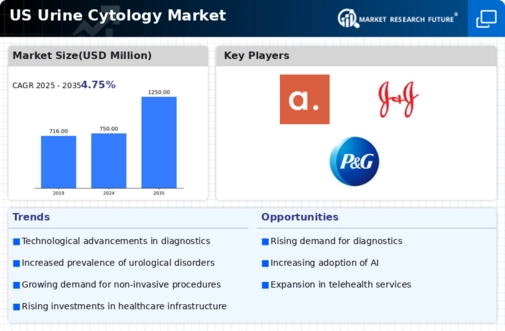Growing Geriatric Population
The aging population in the US is a significant driver for the urine cytology market. As individuals age, the risk of developing urinary tract disorders, including cancers, increases. The geriatric demographic is projected to expand, with estimates suggesting that by 2030, nearly 20% of the US population will be over 65 years old. This demographic shift is likely to result in a higher demand for urine cytology services, as older adults require more frequent screenings and diagnostic evaluations. The urine cytology market is thus poised to capitalize on this trend, as healthcare providers adapt to meet the needs of an aging population.
Advancements in Laboratory Techniques
Innovations in laboratory techniques are significantly influencing the urine cytology market. The introduction of automated systems and enhanced staining methods has improved the accuracy and efficiency of cytological examinations. For instance, the use of liquid-based cytology has been shown to increase the sensitivity of detecting malignant cells, which is vital for timely intervention. As laboratories adopt these advanced techniques, the demand for urine cytology services is likely to rise. The urine cytology market is expected to experience growth as healthcare facilities invest in state-of-the-art equipment to enhance diagnostic capabilities and meet the increasing patient load.
Increased Awareness of Cancer Screening
There is a growing awareness among the US population regarding the importance of cancer screening, particularly for bladder cancer. Public health campaigns and educational initiatives have emphasized the need for early detection, which has led to an uptick in screening practices. This heightened awareness is driving the demand for urine cytology tests, as they are a non-invasive method for identifying potential malignancies. The urine cytology market stands to gain from this trend, as more individuals seek out screening options to ensure their health and well-being. This shift in public perception is likely to sustain market growth in the coming years.
Rising Incidence of Urinary Tract Disorders
The increasing prevalence of urinary tract disorders in the US is a primary driver for the urine cytology market. Conditions such as bladder cancer and urinary tract infections are becoming more common, leading to a heightened demand for effective diagnostic tools. According to recent statistics, bladder cancer accounts for approximately 5% of all new cancer cases in the US, necessitating advanced cytological evaluations. This trend indicates a growing need for urine cytology services, as early detection is crucial for improving patient outcomes. The urine cytology market is thus positioned to benefit from this rising incidence, as healthcare providers seek reliable diagnostic methods to address these health challenges.
Regulatory Support for Diagnostic Innovations
Regulatory bodies in the US are increasingly supportive of innovations in diagnostic technologies, which is beneficial for the urine cytology market. Initiatives aimed at expediting the approval process for new diagnostic tools encourage research and development in this field. For example, the FDA has implemented programs to facilitate the introduction of novel cytological techniques that enhance diagnostic accuracy. This regulatory environment fosters innovation and encourages manufacturers to invest in the urine cytology market, potentially leading to the development of more effective diagnostic solutions that can improve patient care.














Leave a Comment